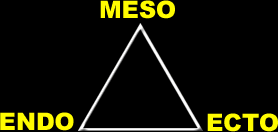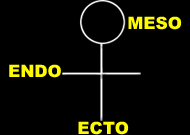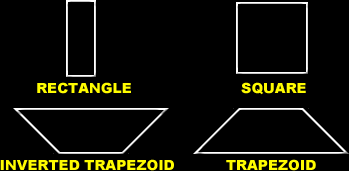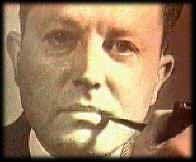The history of somatotyping goes to back to the pioneering work of William Sheldon who proposed three basic body types or somatotypes. Sheldon reasoned that everyone could be classified as some combination of these basic types and attempted to correlate personality features with those types.
While the connection to psychological attributes is tenuous at best; from a fitness perspective, the three body types have survived and guide dietary and training recommendations to this day. Except for the extreme examples of Sheldon's three basic body types, advice for mixtures (where most individuals seem to fall) is haphazard at best. In addition, other workers have expanded on Sheldon's work (with regards to specific dieting advice) and identified four body types that encompass the Sheldon set of three and one apparent extra type (sometimes limited to females). Many of these investigators have tried to tie these physical characteristics to other aspects of physiology such as glandular function along with personality traits.
Unfortunately, previous descriptions of body types do not adequately describe the variety of the human form and distract from the ultimate goal, which is to identify and quantitate elements that contribute to an individual's underlying body type that is unchangeable once maturity has been reached. Instead, a different methodology will be proposed here to definitively describe an individual with a designation that is constant over time regardless of fluctuations in overall weight and muscle mass.
Background On Sheldon
William Sheldon described three general body types referred to as Ectomorph, Mesomorph, and Endomorph. Sheldon derived these names from the three basic cell types that develop into the various tissues and organs of a mature adult during embryogenesis. He reasoned that dominance of one cell type would lead to adult features that reflect this dominance in terms of outward appearance and correlate with personality. It's important to remember that Sheldon was seeking to characterize personality from a person's appearance.
Ectomorphs:
 Ectomorphs are described as tall and thin with a delicate build and small bones. They are lightly muscled and typically have trouble gaining weight either in the form of fat or muscle. In terms of physical activity, they may perform well in endurance events. Sheldon also suggested that due to lack of muscle and body fat, ectopmorphs excelled at mental tasks. Obviously, Sheldon stereotyped ectomorphs as introverted, bookworm types.
Ectomorphs are described as tall and thin with a delicate build and small bones. They are lightly muscled and typically have trouble gaining weight either in the form of fat or muscle. In terms of physical activity, they may perform well in endurance events. Sheldon also suggested that due to lack of muscle and body fat, ectopmorphs excelled at mental tasks. Obviously, Sheldon stereotyped ectomorphs as introverted, bookworm types.
Mesomorphs:
 Mesomorphs are described as muscular or athletic individuals with hard, angled, mature appearing bodies. They gain muscle quite easily, but add little or no fat. From a psychological standpoint, mesomorphs are action oriented, rather than mentally focused. Mesomorphs are stereotyped as dumb jocks.
Mesomorphs are described as muscular or athletic individuals with hard, angled, mature appearing bodies. They gain muscle quite easily, but add little or no fat. From a psychological standpoint, mesomorphs are action oriented, rather than mentally focused. Mesomorphs are stereotyped as dumb jocks.
Endomorphs:
 Endomorphs are described as larger individuals with a rounded and softer appearance. They are believed to have trouble losing weight, especially fat. While Sheldon described them as gaining muscle easily, others have regard them as non-athletic with little musculature. Sheldon believed that their focus was on the gastrointestinal tract with little interest in activity resulting in the stereotype of an easy going, lazy, overweight person.
Endomorphs are described as larger individuals with a rounded and softer appearance. They are believed to have trouble losing weight, especially fat. While Sheldon described them as gaining muscle easily, others have regard them as non-athletic with little musculature. Sheldon believed that their focus was on the gastrointestinal tract with little interest in activity resulting in the stereotype of an easy going, lazy, overweight person.
Obviously, none of Sheldon's categories are overly appealing. In addition, Sheldon relied on visual inspection of the individual to assess their dominant somatotype, which can clearly change over time with weight fluctuation and exercise. Heath and Carter later, developed a more quantitative system rather than visual inspection that Sheldon relied on. In this system, skin fold thickness is used to determine the extent of endomorphy, a height/weight 1/3 ratio (a cubic relationship, different from the body mass index or BMI) or ponderal index is the measure of ectomorphy, while measurements of elbow and knee bone breadths plus arm and calf girths (corrected for skin folds) measure mesomorphy. Body typing as applied today analyzes specific body types associated with specific athletic activities using the Heath-Carter scale to grade an individual for each of the three types.
The major criticism of Sheldon is that he worked largely from appearance. He used photographs to type people. For body typing to be useful, it should not merely rely on appearance. Rather, body typing must reflect underlying features that are unchangeable in the individual. In other words, as an individual gains or loses weight, his underlying body type should not change. An emaciated endomorph should not turn into an ectomorph; yet, with the Heath-Carter system, this is exactly what happens since the ponderal index will increase as weight declines and the resulting body type score will assume more of an ectomoprhic character (because of less weight) and less endomorphic character (because of thinner skin folds).
Another way of stating this is that according to Heath-Carter, an endomorph that becomes lean is less of an endomorph, since the degree of leaness (as defined by skinfold thickness) varies opposite to the degree of endomorphy. This simply cannot be logical. If endomorphs are suppose to have trouble losing weight, while ectomorphs have trouble gaining weight, Heath-Carter suggests that once an endomorph loses weight, their weight problems will be over since they cease to be endomorphic and acquire the ectomorphic weight gain dilemma. Experience argues against this concept in favor of a constancy of body type. Most hardgainers are always hardgainers and those with trouble losing weight must always be vigilant especially when their weight is reduced.
Somehow, the body type must reflect aspects of the physical body that are beyond the control of the individual. The Heath and Carter system is fundamentally flawed since measurements rely on potentially controllable parameters that can be changed over time. All the measures in the Heath-Carter scale rely on attributes that are controllable to some extent by the individual: ectomorphy uses weight, endomorphy uses skinfolds, and mesomorphy uses muscle girths.
Heath-Carter presents more of a snapshot of where someone is right now, rather than an assessment of what their genetic potential and limitations may be. The real value in body typing is not to assess what sports are ideal for an individual with their current status, but rather to assess their genetic potential and customize diet and exercise training routines to work towards an ideal with their specific body type.
Other Systems
Others groups have followed on Sheldon's work adding their own unique features. A common body typing system uses glandular terminology in place of Sheldon's terms. In this case, the Thyroid type replaces the Ectomorph term. Adrenal type replaces Mesomorph and Pituitary replaces Endomorph. In these schemes, dominance of a gland (in some physiological sense) is presumed to have forced development to produce the physical features and may also bo the source of food cravings.
There is some logic to this scheme in that an overactive thyroid (hyperthyroidism) does result in the physical appearance of ectomorphic features. Whether glandular dominance exists in the physiological realm is an unproven hypothesis. Interestingly, in these schemes a fourth category is added for women termed gonadal, but avoided in men. This fourth type has the appearance of a stereotypic 'pear shaped' female, narrow shoulders and wide hips. It could be thought of as an extreme endomorph. Sheldon can be forgiven for missing this type since he studied mostly males, not unsurprisingly given he did this work in the 1940's and staring at females body shapes would have been suspect.
Identifying Unbiased, Behavior-Independent Parameters For Body Typing
As described above, Sheldon relied on visual appearance to type an individual. The Heath-Carter system attempts to remove observer bias and add quantitative measures by relying on a series of physical measurements. The other systems that are derivatives of Sheldon are based largely on visual appearance, but in concert with Sheldon, add additional parameters such as personality features, presumed to correlate with specific body types as well as food cravings. All of these measures suffer in that they utilize features that can vary within an individual as a function of weight or simply do not directly address aspects of the individual's anatomy which should form the basis of the true body type.
The range of diversity in body shapes among the population as well as accumulated experience with endurance and strength training suggests that there must be some features of distinguishing body types that will have continued relevance for an individual regardless of the changes in their body that occurs with diet modification and exercise training.
Ideally, an individual with ectomorphic or endomorphic features should be able to train towards a muscular, lean idealized ectomorphic or endomorphic physique that approaches their own genetic potential. Under Sheldon scheme, as well as Heath-Carter, a muscular, lean body will always type as mostly mesomorphic.
In the search for a truly objective, constant measure of an individual, Heath-Carter lightly touched on the most unchanging feature of human anatomy, namely, the skeletal system. Once maturity is reached, the dimensions of the skeletal system are relatively fixed. Bone density may vary throughout a lifetime, but the overall dimensions are stable, at least relative to the potential fluctuations in muscle and fat mass. Thus, skeletal dimensions should provide the best measure for evaluating body type diversity.
Using Skeletal Dimensions To Describe Body Types

Sheldon identified three general body types and placed individuals on a triangle where each vertex represented the extreme of each type. The triangle model is useful since three skeletal measures will be used; however, unlike Sheldon these measures are not isolated and independent of one another.
Just as a determination of body fatness cannot be made with only an absolute measure of fat mass (it needs to be normalized to overall weight, so that % body fat defines fatness), a single skeletal measure by itself is uninformative.
It must be compared to other measures to indicate its significance. In this typing scheme, rather than each vertex representing the degree of a specific body type, each side of the triangle illustrates the positioning along the possible spectrum of anatomic variation. Each point of the vertex becomes merely the absolute measure for that feature, but the comparison of and relationship to the other features reveals the body type.
For the ectomorphic measure, skeletal height is most appropriate. This choice follows from Sheldon's description of the classic ectomorph, a tall, thin build. Clearly, height is the dominant skeletal features of the ectomorphic dimension. For both the endomorphic and mesomorphic measures, skeletal dimensions perpendicular to height are chosen. The dominant feature of a mesomorph is the classic, inverted triangle with the triangular base across the shoulders and narrowing towards the hips.
Therefore, the width of the shoulders is used as the measure for mesomorphy. In this case, the measure is the biacromial breadth, that is the distance from the extreme lateral extent of the bony elements of the shoulders (the bone of the shoulder is named the acromion). For the endomorphic dimension, the most prominent feature is a rounded appearance. The way to achieve roundness (when viewed from a front view) is to widen the body frame at a point approximately half of the overall height.
The skeletal element in this region is the pelvis. Again a breadth measurement is chosen rather than a circumference so that body fat and muscle have as little influence. This measurement is of the distance between the iliac crests which are the upper edges of the sides of the pelvis on the flanks known as the bi-iliocristal breadth (also known as the bi-iliac breadth).
Now that the three measures of the fundamental body axes have been defined, they allow for body typing. As will be seen, these three measures result in four distinct body types rather than the three that Sheldon originally proposed. Again, returning to Sheldon's triangle, instead of measuring each axis separately, the ratios between them will place an individual along each side of the triangle.
The Skeletal Axes Can Be Depicted As Follows (where the circle represents the head):

In terms of endomorphic versus ectomorphic (the bottom side of the triangle), the ratio of the hips (biiliocristal breadth) to the height is the parameter that positions an individual along the endomorph/ectomorph line. Thus, an individual with a large ratio lies closer to the endomorphic vertex, while a smaller ratio is closer to the ectomorphic vertex.
Similarly, the line connecting mesomorphic and ectomorphic vertices (the right side of the triangle) represents the ratio of shoulder width (biacromial breadth) to height; again with a larger ratio favoring the mesomorphic vertex and smaller ratios favoring ectomorphic. Finally, the ratio of shoulders to hips determines the final side of the triangle (left side). A large ratio favors meso, while a smaller ratio favors endo.
Since measurements are scaled or normalized to each other, one parameter can be arbitrarily chosen as a reference point. Height or the ecto dimension is the logical choice since body types are not regarded as specific to tall or short individuals (although they may correlate with height). In addition, since men and women average difference heights, this bias can be removed in terms of assigning body types that favor height. Also, the remaining axes are both perpendicular to height; therefore, the body types will reflect the relationship between the meso and endo axes with the ecto axis serving as the scaling factor. From this type of analysis, four basic body types emerge.
They Can Be Represented Geometrically As Follows:

Three of these four body types can be related to Sheldon's original somatotypes. The Inverted Trapezoid represents the classic mesomorph, wide shoulders with narrow hips. The Trapezoid represents the classic endomorph with wide hips (relative to height) and shoulders that are narrower relative to hips. The Rectangle represents the classic ectomorph with both, narrow shoulders and hips and height dominating the form. The additional type results from an individual with both wide hips and wide shoulders. This form was not part of Sheldon's scheme, but is likely more common, particularly in men than the more classic endomorphic pattern. In Sheldon's scheme, this type would be regarded as a mixture of both mesomorph and endomorph. In order to retain some continuity with Sheldon's terminology, this type will be referred to as a Mesendomorph.
The mesendomorph deserves some special consideration since most men classified as endomorphs are probably, more likely mesendomorphs (women would most likely predominate the pure endomorph category). They have qualities of gaining both muscle and fat easily. Their square body type gives them the appearance of a stocky physique, rather than the classic mesomorph with broad shoulders and narrow hips. This square form also means that any weight gain, especially in the midsection will overemphasize traditional endomorphic qualities. While the mesendomorph has broad shoulders, the wider hips detract from the visual appearance of broad shoulders. On the other hand, as will be discussed below, they have the capacity for both muscle and fat gain quite easily.
In fact, mesendomorphs most likely have a greater capacity for muscle gain than their mesomorphic peers, but their level of body fat may obscure muscular definition that implies muscle mass. True mendomorphs are oxen among their peers. They comprise football linemen, participants in strongman contests, powerlifters, Olympic weightlifting contestants, and probably most noticeable to the general population, professional wrestlers. All of these categories contain individuals with ultimate strength and bulk, but lacking the visual appearance typically associated with massively lean musculature.
Significance Of Body Types
The value in body typing is to identify characteristics of each type that influence diet and training styles on the assumption (amply displayed in practice) that these types respond differently to both inputs. Unfortunately, Sheldon did not provide a physiological or anatomic basis for why different body types should respond differently (beyond the dominance of embryonic cell types which still doesn't provide insight).
Subsequent attempts to link glandular function only serve to create another layer of questions as to why different glands should dominate different body types. Fundamentally, features of the skeletal structure should provide clues as to the basis of differential responses. Therefore to understand why different body types behave differently as well as why they cannot be changed (since the underlying skeletal structure cannot be modified), the effects of varying the perpendicular axes (shoulder and hips) needs to be examined.
Contrary to popular belief, the wide hips feature of an endomorph does not preclude muscle gains, especially in the lower body; muscular features are simply associated with wide shoulders because of the classic inverted trapezoid appearance associated with bodybuilding. More accurately, longer axes perpendicular to height result in a larger muscle mass and therefore greater potential for mass gains. Why should this be so? Inspection of many of the large muscles (that produce not only a muscular appearance, but strength as well) reveals that many have their origins near the midline of the body. Lats for examples which create the classic V-shape of the torso, start along the spine and extend laterally to reach the humerus (the upper arm bone). Along this path, they must cross the lateral extent of the shoulders (the acromion).
A wider shoulder breadth requires more muscle belly to traverse the longer distance. The larger muscle belly gives more muscle mass and greater potential for gains from the untrained state because of greater surface area of the muscle. Similarly in front, pecs begin near the midline on the sternum (breastbone) and also attach to the humerus, again traversing the full shoulder breadth. With the lower body, this effect holds for the gluts, but is not applicable to the quads which do not originate near the midline.
Thus, for the lower body, a wider frame has some potential for greater mass simply as a result of a wider frame. In summary, a wide body frame, both shoulders and hips or either one singly results in bigger muscles as well as greater potential for muscle mass gains.
The next issue to address is why a high endo/ecto ratio results in greater weight gain from body fat. Inspection of the human body reveals that the major fat depots are located primarily in the region surrounding the pelvic diameter. In women, the region just below the pelvic frame (buttocks, hips, and thighs) is the major location of the additional percentage body fat that women carry relative to men. For men, the area just around this axis is utilized either as intra-abdominal fat (fat underneath the stomach muscles), the classic 'pot belly' or 'beer gut' or outside the stomach musculature, just under the skin (subcutaneous fat) in the form of a 'spare tire.'
The rationale for storing fat in these locations is straightforward. Locations higher on the body would raise the center of gravity and interfere with activity. In addition, the abdominal region is fairly open and accommodates body fat quite easily. The upper body is bounded by the skeletal frame of the rib cage which is completely filled by the lungs. Fat storage within the rib cage would compromise lung function considerably. Subcutaneous storage of body fat high on the body would interfere with function (upper body movement) much more severely than a spare tire interferes with lower body movement because the upper body has needs of a greater range of motion compared to the lower body (the shoulder joint for example has a much greater range of motion compared to the hip joint).
This then begs the question why a wider pelvic frame promotes greater body fat gain. Given the same torso dimension in terms of height, a doubling of the pelvic breadth results in a four-fold increase in the potential volume for storing body fat as well as a four-fold increase in the surface area of skin. Thus, a wider frame (in the pelvic region) provides more potential for body fat storage in a manner analogous to muscle gains from a wider frame. In fact, for the general population, height and bi-iliocristal breadth are pretty good predictors of overall body mass suggesting that variation in this parameter is a major determinant of overall body weight. Scientists, for example use these skeletal features to estimate body weights of prehistoric skeletons.
Implications Of Four Body Types
The major usage of body types is to individualize training routines. With a skeletal basis for body types, an individual can gain a better appreciation for their own genetic potential. Inherently, there is no physiological reason that any body type cannot increase muscle mass and decrease fat mass. Many of the training routines adopted for Sheldon's classic body types are applicable for this new classification. The mesendomorph is similar to the oft used term meso-endomorph and likely to be a reflection of both types in terms of muscle gains and weight control.
The Next Step
This discussion has introduced a new approach to objectively classifying body types. Unfortunately, anthropomorphic data to identify individuals by this method are not yet available. Measurements of biacromial and bi-iliocristal breadths may be present in databases somewhere, but are not readily accessible. At this point, one cannot assess individual biacromial and bi-iliocristal breadths relative to their own heights because cutoff values for placing someone along the spectrum of endo/ecto, meso/ecto, and meso/endo are not readily available.
The defense department and NASA most likely have the most extensive databases given their unique requirements for specialized clothing and equipment for their personnel. The defense department for example, produced the most accurate equations for body fat determination based on height and body circumference measurements in the 1980's. The raw data is likely stored in some governmental database waiting to be tapped.
Ideally, the best place to begin would be to assemble data on existing bodybuilders. This would establish a range that could be compared with the general population for validation of the underlying theory and allow establishment of cutoff points between the various measures. More importantly, individuals would then have standards to compare their own potential and progress as they train. In addition, one cannot dismiss the seemingly contradictory training advice from various successful bodybuilders and the inability for all bodybuilders to productively apply these various routines into their own training.

Dr. William H. Sheldon (1898-1977)
A Forgotten Giant of American Psychology
With identification of successful bodybuilders of various body types, an individual would be able to identify comparable bodybuilders of a similar body type and then select training routines that have worked for that group. Under the current Heath-Carter system, this is not possible since all successful bodybuilders are largely typed as mesomorphic. Only with a skeletal based body typing scheme can an individual visualize and train towards their true genetic potential.
Thanks,
